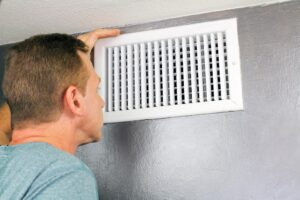Heat pumps are a cost-effective, energy-efficient way to heat and cool your home. Let’s learn how a heat pump works in Kunkletown, PA, and why they’re an intelligent investment for any homeowner.
What Is a Heat Pump?
A heat pump is an HVAC system that transfers heat from one place to another. Heat pumps use electricity to operate and are an energy-efficient alternative to traditional heating and cooling systems.
How Do Heat Pumps Work?
A heat pump is an energy-efficient way to heat and cool your home, and unlike traditional heating and cooling systems, a heat pump does not generate heat or cool air. Instead, it transfers heat from one place to another. The following is a step-by-step of how a heat pump works.
Step 1: The Refrigerant Absorbs Heat
The heat pump’s outdoor unit pumps the refrigerant, which can absorb and release heat to begin the process. The outdoor unit contains a tubing coil designed to allow heat to be transferred. As the refrigerant flows through the coil, it absorbs heat from the outside air during the winter and releases heat during the summer months, through the use of a reversing valve.
Step 2: Compression of the Refrigerant
The compressor in the outdoor unit compresses the refrigerant after it absorbs heat from the outdoor air. The compression of the refrigerant increases its temperature and pressure, causing it to become even hotter.
Step 3: The Hot Refrigerant Flows to the Indoor Unit
The hot refrigerant then flows through a refrigerant line into the heat pump’s indoor unit. The indoor unit contains another coil of tubing known as the evaporator coil.
As the hot refrigerant flows through the evaporator coil, it loses heat to the indoor air. And the blower of the indoor unit then pushes this heated air out through the ductwork.
Step 4: The Refrigerant Expands and Cools Down
As the hot refrigerant passes through the evaporator coil, it expands and cools. The expansion of the refrigerant causes it to lose pressure, which cools it down. As it evaporates, the refrigerant becomes a gas, and the indoor unit forces it through and out of the refrigerant line back to the outdoor unit.
Components of a Heat Pump
A heat pump has two main components. It has an indoor unit and an outdoor unit. The outdoor unit contains the compressor, which circulates the refrigerant, and the fan, which moves air across the coils.
Also, the heat exchanger transfers heat between the refrigerant and the air. Conversely, the indoor unit contains the evaporator, which absorbs heat from the air, and the blower, which moves air across the coils.
Types of Heat Pumps
There are three main types of heat pumps: air-source, ground-source and water-source. Air-source heat pumps are the most common and extract heat from the outside air.
Ground-source heat pumps, also known as geothermal heat pumps, use the ground’s constant temperature to heat and cool your home. Water-source heat pumps extract heat from a nearby body of water, such as a pond or lake.
Benefits of Using a Heat Pump
- They’re much more energy efficient, which can lead to significant savings on your energy bills.
- They’re much safer than traditional heating systems, as they don’t produce any carbon monoxide or other harmful gases.
- Heat pumps are more eco-friendly than traditional heating systems, as they don’t burn fossil fuels.
- They can also heat and cool your home year-round, making them a versatile heating and cooling solution.
Installation and Maintenance
A professional should install a heat pump. The installation involves mounting the outdoor unit, running refrigerant lines, running electrical wires and installing the indoor unit.
Once technicians install your heat pump, it requires maintenance usually twice per year. It’s essential to clean or change the air filters regularly, usually every 90 days, by the homeowner.
Reliable HVAC Services in Kunkletown, PA
Heat pumps are effective and flexible heating and cooling systems. So, why wait any longer? Contact us at Sullivan Oil and Propane for consultation with our professionals on installing the best heat pump system for your home.
Image provided by iStock



